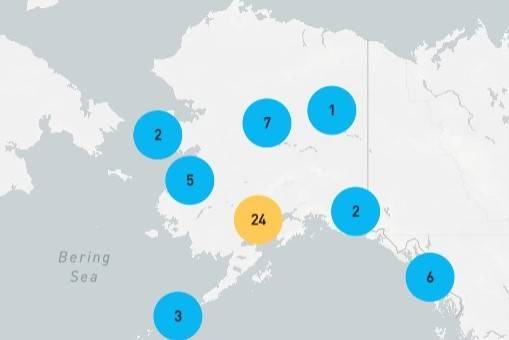The Department of Energy announced $12 million in funding for energy cost reduction efforts in 13 American Indian and Alaska Native communities across the country, seven of which are in Alaska.
In a news conference Tuesday held via teleconference , U.S. Secretary of Energy Jennifer Granholm; Sen. Lisa Murkowski, R-Alaska; and Wahleah Johns, senior adviser for the DOE’s Office of Indian Energy Policy; and Programs and Metlakatla Indian Community Tribal Council member Keolani Booth said the grant money would help Indigenous communities reduce costs and move toward more sustainable energy production.
“We want to thank the federal government for its investment into our community,” said Keolani Booth, tribal council member from the Metlakatla Indian Community, one of the communities receiving funding. “This opens up many new options.”
Metlakatla will receive more than $1 million to complete an intertie project to nearby Ketchikan that will lower prices for consumers. In a prepared statement, Booth said the project had been in the works for about 20 years but thanks to assistance from state and national politicians the project was becoming a reality. Booth thanked state politicians Rep. Dan Ortiz, I-Ketchikan, and Sen. Bert Stedman, R-Sitka, for their work on the project as well as Murkowski, whom he called“our longtime and beloved senator.”
The other communities in Alaska receiving grants are the Akiachak Native Community; the Native Village of Kipnuk; the Native Village of Diomede; the Native Village of Noatak and the Northwest Arctic Borough; the Village of Aniak and the Village of Chefornak. American Indian communities in California, Florida, Washington and Colorado will also receive grants.
“There 573 federally recognized tribes in the country,” Murkowski said at the conference, “and 231 are in Alaska.”
[Forest Service set to approve Kensington expansion]
Murkowski said energy costs in rural Alaska can be up to 800% higher than the national average, and that constituents have told her stories about having to choose between paying energy bills and buying food for their children. The projects in many of the grants were not significant changes, she said, but investments in upgrades that would save money and help to make communities more energy independent.
According to DOE, funding will go to a variety of projects including the construction of electrical intertie projects, installation of solar panels and batteries and LED light upgrades. Many of the projects funded will build renewable energy projects like solar, including in Alaska, but several projects in the state are aimed at bolstering the efficiency of existing diesel-generated power.
The Akiachak Native Community is set to receive $123,000 to install energy efficiency measures on five essential multi-use buildings, according to a DOE breakdown of the projects. Energy-efficient retrofits include more efficient furnaces in the laundry building, an LED lighting upgrade and installation of setback thermostats in all five buildings.
According to DOE, the upgrades will save the community more than $17,000 in energy costs annually and $2,000 in annual maintenance.
Completing the electrical intertie between will reduce costs by significantly decreasing or eliminating the use of diesel generators, DOE said. The department estimates the project will save $516,970 annually and nearly $26 million over the 50-year life of the systems.
But power sales agreements still need to be negotiated between several stakeholders, according to Jeremy Bynum, acting division manager at the Ketchikan Public Utility. The intertie would connect Metlakatla with the energy grids of not just Ketchikan but Petersburg and Wrangell as well. All three of those communities are members of the Southeast Alaska Power Agency, and while conversations about the project had taken place Bynum said, the relationship between the entities was complicated.
“There’s been a lot of conversation occurring between the utility, SEAPA, I think we’re still pretty early in the process in terms of coming up with a power sales agreement,” Bynum told the Empire by phone Tuesday. “I know there’s been a lot of design work. We do have a preliminary design of how and where we would make an intertie connection.”
Granholm said at the conference the Biden administration is making efforts to hold more tribal consultations and include the input of tribal governments.
“We’ll make sure the communities that have often gone unseen or unheard, and that includes all too many tribal governments across the nation, will be heard,” Granholm said.
The secretary said the grants were part of the Biden administration’s Build Back Better campaign and called funding for renewable energy projects “once in a century investment.” Granholm said additional projects are being negotiated in the infrastructure package currently being championed by President Joe Biden.
But negotiations are still ongoing, Murkowski said.
“There’s still a fair amount of back and forth that’s going on,” Murkowski said. “That’s good, discussions are happening in earnest.”
Projects were selected by a committee and based on scoring criteria, Johns said, saying she and the Office of Indian Energy had worked with local communities to identify projects. Local communities are paying for some of the costs but the majority of the funding is coming from the grants, according to DOE.
The Metlakatla Indian Community owns a public utility, Metlakatla Power and Light, which will be responsible for the maintenance of the intertie, according to Booth.
Booth said federal funding for energy projects helps communities like Metlakatla become more independent.
“We cherish our independence but we also recognize we are all stronger when we are connected,” Booth said.
• Contact reporter Peter Segall at psegall@juneauempire.com. Follow him on Twitter at @SegallJnuEmpire.

